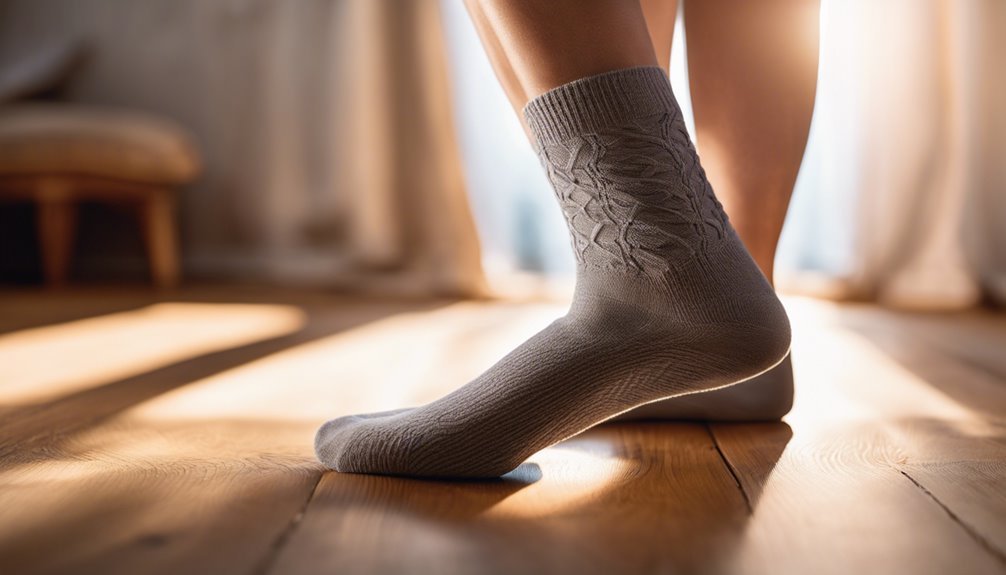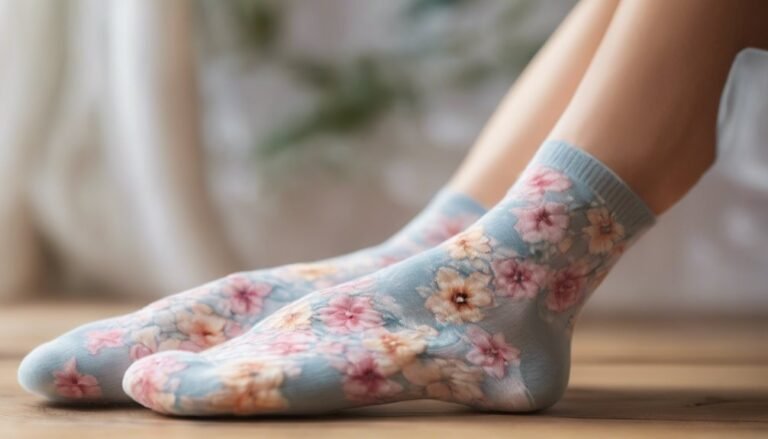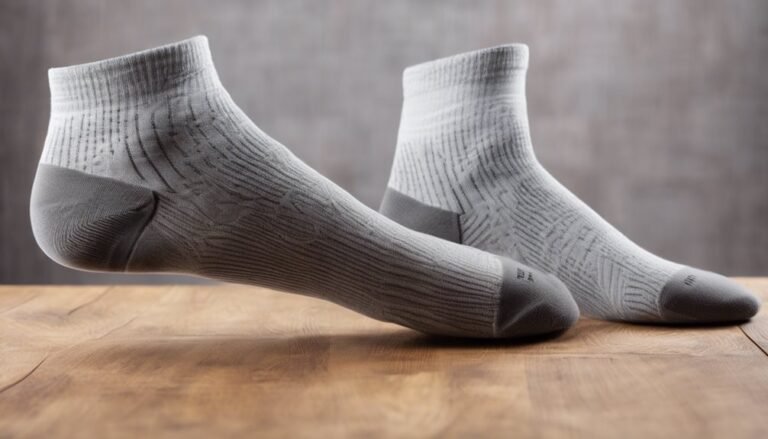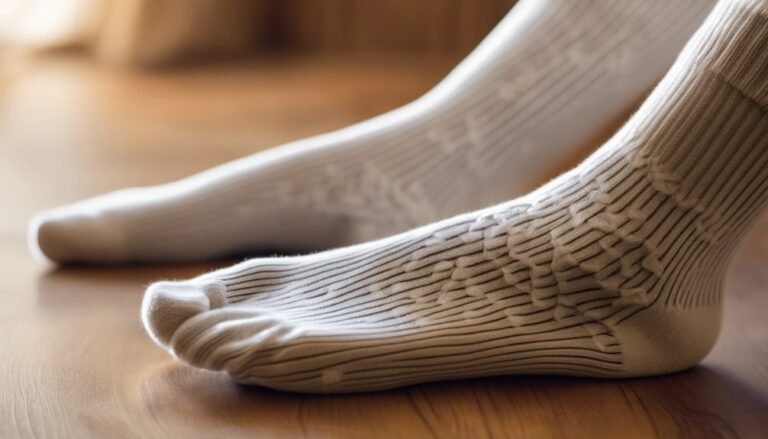Why Diabetic Socks Are Important for Circulation
Diabetic socks are essential for improving circulation in individuals with diabetes. Their gentle compression promotes better blood flow to your feet and lower legs, reducing the risk of complications. With features like moisture-wicking properties, seamless designs, and non-binding tops, these socks help prevent irritation and sores. Adequate cushioning supports sensitive areas, enhancing comfort. By choosing the right diabetic socks, you can substantially impact your foot health and overall well-being. Learn more about how to optimize your foot care routine.
Understanding Diabetes and Its Impact on Foot Health
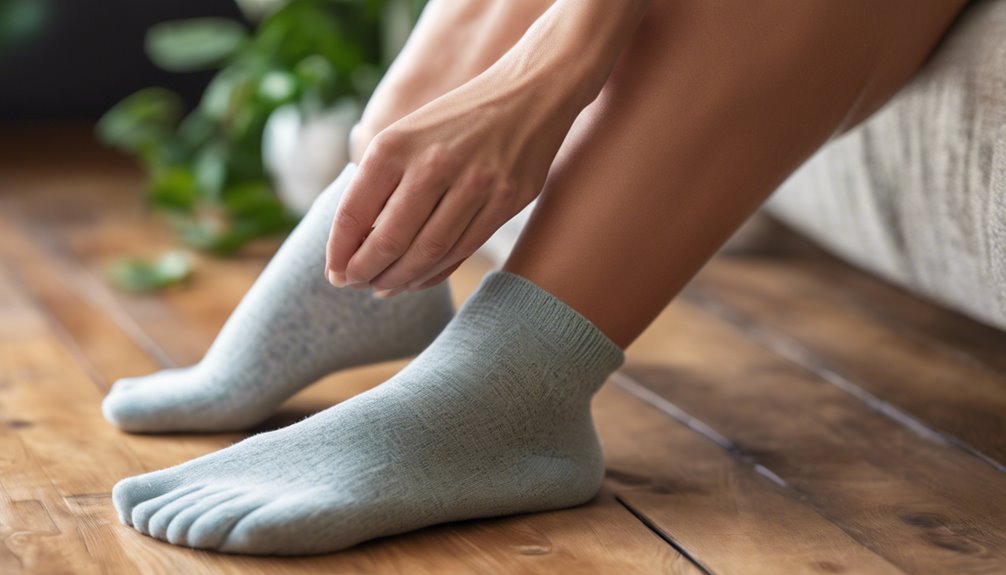
As diabetes progresses, it can greatly affect foot health due to complications like neuropathy and poor circulation. You might experience foot neuropathy, which results in numbness, tingling, or pain, making it difficult to detect injuries or pressure points. This lack of sensation can lead to unnoticed wounds, increasing the risk of infections and potential amputations. Moreover, poor circulation means that your feet may not receive adequate blood flow, hindering healing and contributing to further complications. Monitoring your foot health is vital; regular check-ups can help identify issues early. Understanding these diabetes complications empowers you to take proactive steps, ensuring you maintain your freedom and mobility. Prioritizing foot health is essential for managing diabetes effectively and enhancing your quality of life.
The Importance of Proper Foot Care for Diabetics
Proper foot care is essential for managing diabetes and preventing complications. You should conduct daily foot inspections to identify any cuts or sores early, as even minor injuries can lead to serious issues. Additionally, maintaining good hygiene and moisturizing your feet can help prevent dry skin and infection.
Daily Foot Inspections
Daily foot inspections are crucial for individuals with diabetes, since even minor injuries can lead to serious complications. Regular foot inspections allow you to identify cuts, blisters, or sores that may go unnoticed. By conducting daily checkups, you can catch potential issues early and seek appropriate treatment, minimizing the risk of infection. Pay attention to changes in color, temperature, or swelling, as these can indicate circulation problems. Remember to check between your toes and the soles of your feet, as these areas are often neglected. If you notice anything unusual, don't hesitate to consult your healthcare provider. Prioritizing foot inspections is a critical step in maintaining your foot health and preventing complications associated with diabetes.
Moisturizing and Hygiene Practices
Maintaining moisture and hygiene is essential for diabetic foot care, as it helps prevent complications such as infections and ulcers. Implementing effective moisturizing techniques is vital. You should apply a diabetic-friendly moisturizer daily, avoiding areas between your toes to prevent excess moisture that can lead to fungal infections. Establishing consistent hygiene routines is equally important. Wash your feet daily with mild soap and lukewarm water, ensuring they're thoroughly dried afterward. Regularly inspect your feet for any signs of irritation or injury. Remember, keeping your feet clean and moisturized not only promotes overall foot health but also enhances your quality of life. By prioritizing these practices, you empower yourself to manage your diabetes more effectively and maintain peak foot health.
How Diabetic Socks Improve Circulation
Although many individuals with diabetes may not realize it, diabetic socks are specifically designed to enhance circulation in the feet and lower legs. The circulation benefits of wearing diabetic footgear can't be overstated. These socks provide gentle compression that promotes better blood flow, helping to reduce the risk of complications associated with poor circulation. This is particularly crucial for those with diabetes, as it can prevent further issues like neuropathy or ulcerations.
| Feature | Benefit | Impact on Circulation |
|---|---|---|
| Gentle Compression | Reduces swelling | Increases blood flow |
| Moisture-Wicking | Keeps feet dry | Prevents skin irritation |
| Seamless Design | Reduces friction | Minimizes discomfort |
| Breathable Materials | Enhances airflow | Supports overall health |
| Non-Binding Top | Prevents constriction | Promotes unrestricted flow |
Key Features of Diabetic Socks
When selecting diabetic socks, you'll want to take into account key features that enhance comfort and support. Look for moisture-wicking fabric to keep your feet dry, non-binding tops to promote circulation, and enhanced cushioning support to reduce pressure on sensitive areas. These elements work together to help maintain foot health and prevent complications.
Moisture-Wicking Fabric
Moisture-wicking fabric is an essential feature of diabetic socks, as it helps to keep your feet dry and comfortable. This innovative fabric technology actively pulls moisture away from your skin, promoting effective moisture management. When your feet stay dry, you're less likely to experience blisters, fungal infections, or other complications that can arise from excess moisture. Additionally, moisture-wicking properties help regulate temperature, ensuring that your feet remain comfortable throughout the day. For those with diabetes, maintaining foot health is vital, and choosing socks made from moisture-wicking materials can greatly contribute to overall well-being. By investing in high-quality diabetic socks with moisture-wicking fabric, you're taking an important step toward protecting your feet and maintaining ideal circulation.
Non-Binding Tops
Maintaining proper circulation is essential for individuals with diabetes, and non-binding tops on diabetic socks play a significant role in this aspect. These specially designed tops eliminate tight elastic bands that can constrict blood flow, providing non-binding benefits that enhance comfort. This feature helps prevent unnecessary pressure on the legs and feet, which is critical for circulation improvement. By ensuring that blood can flow freely, non-binding tops reduce the risk of complications associated with poor circulation, such as swelling and neuropathy. Choosing diabetic socks with this characteristic allows you to enjoy greater freedom while prioritizing your health. Overall, non-binding tops are an important feature that contributes to the overall effectiveness of diabetic socks in promoting better circulation.
Enhanced Cushioning Support
Enhanced cushioning support is an essential feature of diabetic socks that greatly contributes to foot health. This support is made possible through advanced cushioning technology designed specifically for individuals with diabetes. The extra padding in these socks provides critical shock absorption, reducing pressure on sensitive areas of your feet. Such support features help prevent blisters, calluses, and other foot complications that can arise from prolonged wear. By opting for diabetic socks with enhanced cushioning, you're not only enhancing comfort but also promoting better circulation and overall foot health. These specialized socks allow you the freedom to engage in daily activities without the worry of foot pain or injury, ultimately improving your quality of life.
The Role of Moisture-Wicking Properties
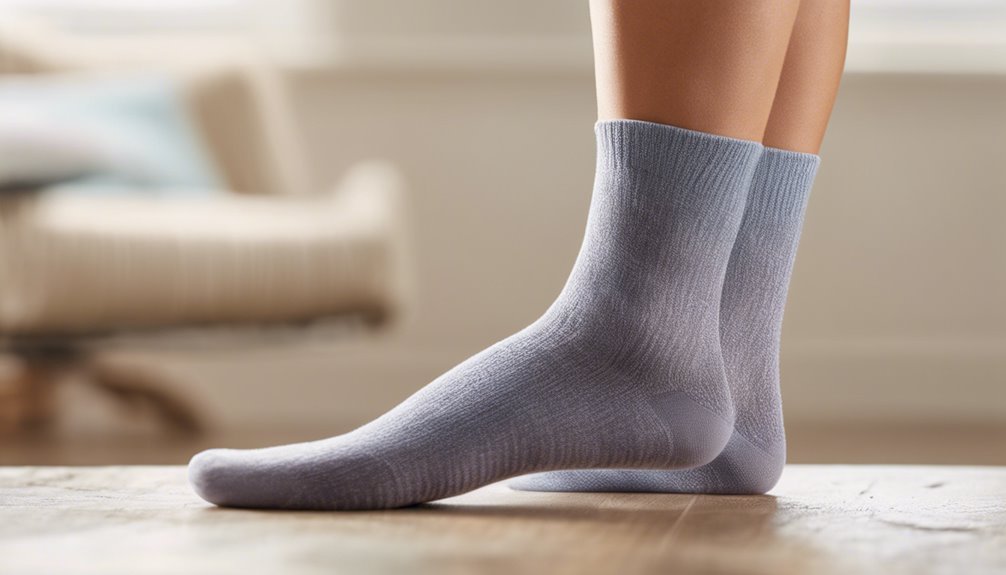
When it comes to diabetic socks, moisture-wicking properties play an important role in maintaining foot health. These specialized socks are designed to enhance moisture absorption, drawing sweat away from your skin. This helps prevent excessive moisture buildup, which can lead to skin irritation or infections—issues that diabetics should avoid. In addition, effective moisture management contributes to temperature regulation, ensuring your feet stay comfortable throughout the day. By keeping your feet dry and at a stable temperature, moisture-wicking socks reduce the risk of blisters and sores, promoting overall foot well-being. This is particularly vital for individuals with diabetes, as they may experience reduced sensations in their feet. Choosing socks with moisture-wicking properties is a proactive step toward healthier feet.
Cushioning and Support for Sensitive Feet
While diabetic individuals often face challenges related to foot sensitivity, choosing socks with adequate cushioning and support can greatly mitigate discomfort. Socks designed with specialized foot padding provide essential protection for sensitive skin, reducing the risk of blisters and sores. The cushioning acts as a barrier against impact, ensuring your feet remain comfortable throughout daily activities. This is particularly important since diabetes can lead to neuropathy, making your feet more prone to injury. By investing in socks that offer both cushioning and support, you can promote circulation while protecting your feet from potential harm. These features not only enhance comfort but also contribute to overall foot health, allowing you to move freely and confidently.
Non-Restrictive Fit: Why It Matters
Choosing the right fit for diabetic socks can greatly impact foot health, especially for those with sensitive feet. A non-restrictive fit is vital for ideal circulation. It allows your feet to breathe and prevents pressure points that could lead to complications. Here are three key reasons why a non-restrictive fit matters:
- Circulation: Improved blood flow is essential for diabetic individuals.
- Comfort: Soft fabric types, like bamboo or cotton, enhance comfort without constricting.
- Fit Adjustments: Look for socks that accommodate swelling without slipping.
Preventing Common Foot Complications
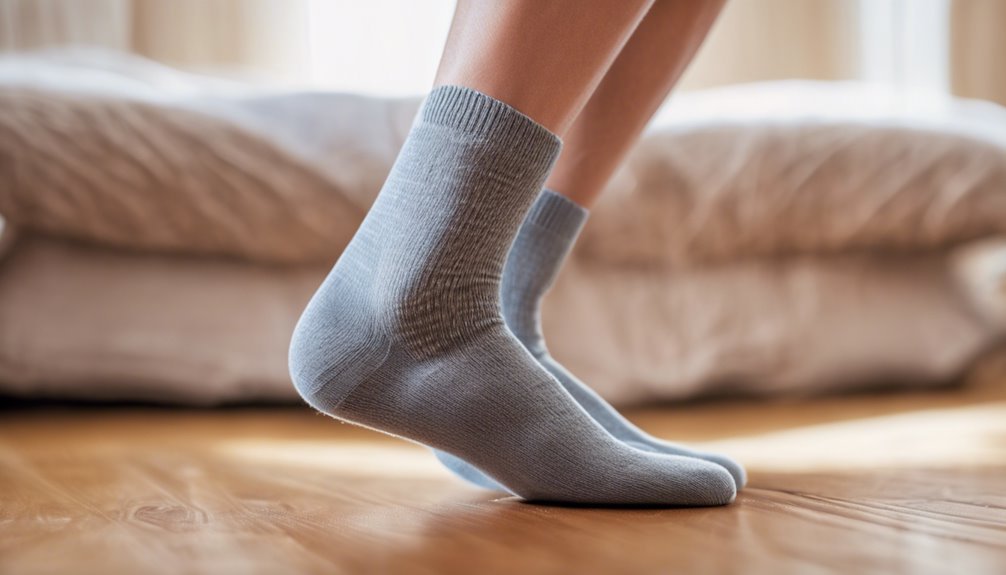
To prevent common foot complications, it's essential to focus on reducing pressure points and minimizing blister formation. Proper moisture control can also greatly enhance foot health, as excessive moisture can lead to various skin issues. By addressing these factors, you can maintain better foot condition and overall well-being.
Reducing Pressure Points
Since pressure points can lead to serious complications for individuals with diabetes, it's crucial to focus on proper sock selection and fit. Diabetic socks are specifically designed to provide pressure relief and comfort enhancement, greatly reducing the risk of foot issues. Consider these key factors when choosing your socks:
- Seamless Design: Eliminates friction and reduces pressure on sensitive areas.
- Cushioned Sole: Provides extra padding where you need it most.
- Proper Fit: Guarantees that the socks aren't too tight, which can restrict circulation.
Minimizing Blister Formation
Effective pressure relief not only helps in preventing complications but also plays an important role in minimizing blister formation. You can employ various blister prevention techniques to safeguard your feet. First, choose diabetic socks made from moisture-wicking materials like bamboo or synthetic blends, which reduce friction and keep your feet dry. These sock material choices can greatly impact comfort and blister risk. Additionally, make sure your socks fit well—neither too tight nor too loose—to avoid pressure points that lead to blisters. Regularly inspect your feet for any signs of irritation, as early detection is vital. By prioritizing these strategies, you can maintain healthy feet, allowing for greater freedom in your daily activities while preventing common foot complications.
Enhancing Moisture Control
Moisture control is essential for preventing common foot complications, especially for those with diabetes. Effective moisture management helps reduce the risk of infections and skin issues. Consider the following benefits:
- Prevents Fungal Infections: Excess moisture creates an environment conducive to fungal growth.
- Promotes Thermal Regulation: Proper moisture control maintains an ideal temperature, reducing the risk of overheating.
- Enhances Comfort: Dry feet contribute to overall comfort, allowing for greater freedom of movement.
Choosing the Right Diabetic Socks
When selecting diabetic socks, it's crucial to prioritize features that enhance comfort and promote better circulation. Look for material types like cotton, bamboo, or synthetic blends, as these can help wick moisture away while providing cushioning. Ascertain the socks are seamless to reduce friction and prevent blisters. Additionally, consider sock sizes carefully; they should fit snugly without being too tight. A proper fit prevents bunching, which can lead to pressure points and compromised circulation. Also, opt for socks with graduated compression if recommended by your healthcare provider, as they can further enhance blood flow. By focusing on these aspects, you can greatly improve your comfort and circulation, allowing you the freedom to engage in daily activities with confidence.
Incorporating Diabetic Socks Into Your Daily Routine
Incorporating diabetic socks into your daily routine is vital for maintaining foot health and promoting circulation, especially for individuals managing diabetes. By making a few adjustments to your daily habits, you can enhance your comfort and well-being. Here are three key steps to remember:
- Choose the right sock selection: Opt for socks made from moisture-wicking materials that provide cushioning without constricting your feet.
- Set a daily reminder: Incorporate wearing diabetic socks into your morning routine to guarantee consistency.
- Monitor your feet regularly: Check for any signs of irritation or circulation issues, addressing them promptly.
Frequently Asked Questions
Can Diabetic Socks Be Worn by Non-Diabetics?
Yes, non-diabetics can wear diabetic socks. They're designed for comfort and can improve circulation, offering benefits like reduced swelling and better foot health. You might find them beneficial even without diabetes.
How Often Should I Replace My Diabetic Socks?
You should replace your diabetic socks every 6 to 12 months, depending on sock durability and wear. Regular replacement guarantees ideal comfort and support, maintaining the benefits that contribute to your foot health and overall well-being.
Are There Specific Brands of Diabetic Socks Recommended?
You'll find several recommended brands of diabetic socks that offer compression benefits. Look for options made from moisture-wicking materials like bamboo or cotton blends to guarantee comfort and support while maintaining circulation and foot health.
Can Diabetic Socks Help With Neuropathy Symptoms?
You might find that diabetic socks offer a gentle embrace, providing neuropathy relief through their cushioned support and seamless design. These sock features can enhance comfort, helping you manage symptoms more effectively during daily activities.
Do Diabetic Socks Come in Different Sizes and Styles?
Yes, diabetic socks come in various size variations and style options. You can find them designed for comfort and support, catering to individual needs while ensuring proper fit to enhance your overall foot health.

